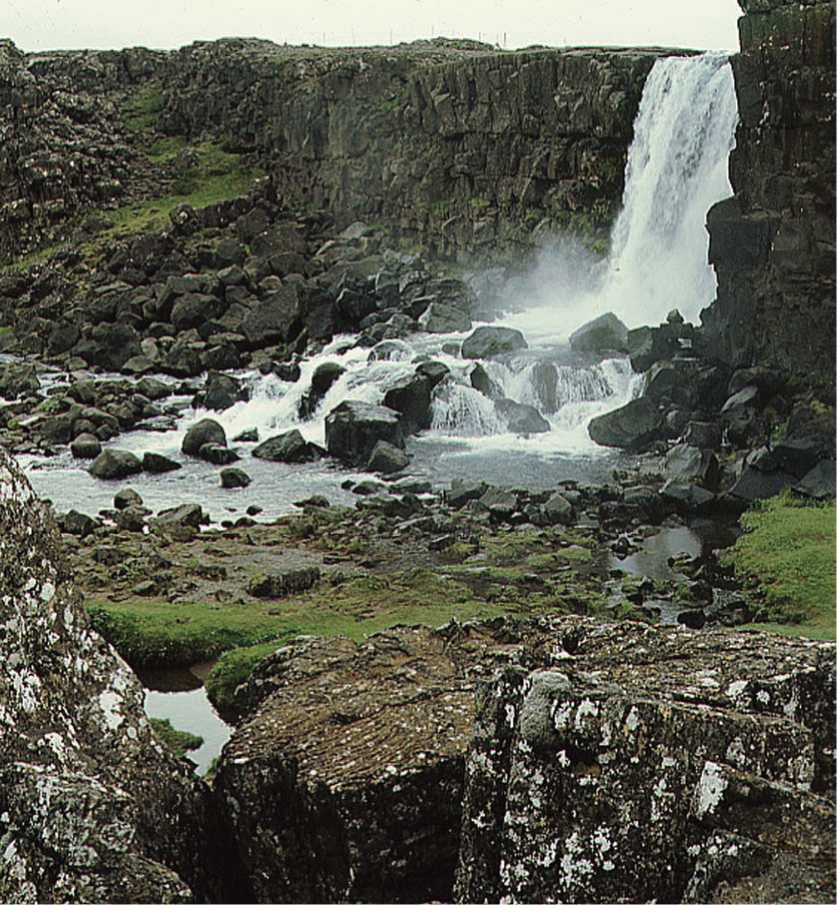The first stages of this seemingly relentless westward migration occurred in the ninth century soon after various

It was in this magnificent natural setting at Thingvelir, Iceland, that the island's national assembly, the Althing, periodically met.
Viking bands began settling parts of England and Scotland. Some of the Norse settlers sailed to the Shetland Islands, lying not far off Scotland's northern coast. And by the late 800s the
Shetlands came under the direct rule of the Norwegian king.
The next step in the migration consisted of the 190-mile (306-km) hop to the windswept, mountainous Faeroe Islands, Situated about 400 miles (644km) directly west of Norway. The first Vikings who landed there found that the islands were not completely uninhabited, as proved by a surviving description penned by an Irish monk in 825: "Some of these islands are very small. Nearly all are separated from the other by narrow sounds. On these islands hermits, who have sailed from [Ireland], have lived for roughly a hundred years."63 The soil in the Faeroes was not suitable for large-scale farming. But the land easily supported the raising of sheep and cattle, which became the basis of the local Norse economy there.
Iceland lies about 200 miles (322km) northwest of the Faeroes, about the same distance as Britain lies south of
Visible are some of the remains of the Viking village at Hvalsey, in southern Greenland, one of the last and westernmost Viking settlements ever constructed.

Them. So it is hardly surprising that enterprising Norse sailors soon discovered and explored the coasts of Iceland. Full-scale settlement of that highly volcanic island began around 870, and by 930 nearly all the good grazing lands along the coasts had been claimed. During that time, a form of national government was established. As in other Viking lands, local freemen in Iceland gathered at the local assemblies, or things, held in settlements spread across the island. They also formed the Althing, an assembly in which only chieftains could vote. The Althing settled disputes among the smaller assemblies and the villages they served. In time, the Althing began deciding island-wide policies. In about 1000, for example, its members agreed that Iceland should try to adopt Christianity. By that time, the island's population was well over thirty thousand.
Next came the exploration of Greenland, lying only a few hundred miles west of Iceland. Viking seafarers first sighted the larger island sometime in the early 900s. Initially they thought it was too cold and icebound to support settlements. But between 980 and 983 an expedition commanded by Erik the Red, who had been born in Norway and later settled in Iceland, located an ice-free region in the southwest. He managed to set up two main colonies. The first became known as the "Eastern" settlement. The other was the "Western" settlement, lying some 300 miles (483km) farther up the western coast.
These colonies, which soon came to support a total population of roughly three thousand, had a mixed economy. At the time, Greenland was in the midst of a warm period that featured much milder temperatures than exist there today. So some crops, including grains, could be grown. In addition, the inhabitants raised cattle and sheep, hunted walruses and polar bears, and traded with roving bands of the native inhabi-tants—the Eskimo, or Inuit.




 World History
World History









